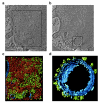Molecular electron microscopy: state of the art and current challenges
- PMID: 18484707
- PMCID: PMC2660199
- DOI: 10.1021/cb800037d
Molecular electron microscopy: state of the art and current challenges
Abstract
The objective of molecular electron microscopy (EM) is to use electron microscopes to visualize the structure of biological molecules. This Review provides a brief overview of the methods used in molecular EM, their respective strengths and successes, and current developments that promise an even more exciting future for molecular EM in the structural investigation of proteins and macromolecular complexes, studied in isolation or in the context of cells and tissues.
Figures




References
-
- Wade R. H. (1992) A brief look at imaging and contrast transfer. Ultramicroscopy 46, 145–156.
-
- Scherzer O. (1948) The theoretical resolution limit of the electron microscope. Appl. Phys. 20, 20–29.
-
- Zhu J.; Penczek P. A.; Schröder R.; Frank J. (1997) Three-dimensional reconstruction with contrast transfer function correction from energy-filtered cryoelectron micrographs: procedure and application to the 70S Escherichia coli ribosome. J. Struct. Biol. 118, 197–219. - PubMed
-
- Adrian M.; Dubochet J.; Fuller S. D.; Harris J. R. (1998) Cryo-negative staining. Micron 29, 145–160. - PubMed
-
- Golas M. M.; Sander B.; Will C. L.; Lührmann R.; Stark H. (2003) Molecular architecture of the multiprotein splicing factor SF3b. Science 300, 980–984. - PubMed
Publication types
MeSH terms
Substances
Grants and funding
LinkOut - more resources
Full Text Sources
Other Literature Sources

